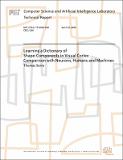| dc.description.abstract | In this thesis, I describe a quantitative model that accounts for the circuits and computations of the feedforward path of the ventral stream of visual cortex. This model is consistent with a general theory of visual processing that extends the hierarchical model of (Hubel & Wiesel, 1959) from primary to extrastriate visual areas. It attempts to explain the first few hundred milliseconds of visual processing and “immediate recognition”. One of the key elements in the approach is the learning of a generic dictionary of shape-components from V2 to IT, which provides an invariant representation to task-specific categorization circuits in higher brain areas. This vocabulary of shape-tuned units is learned in an unsupervised manner from natural images, and constitutes a large and redundant set of image features with different complexities and invariances. This theory significantly extends an earlier approach by (Riesenhuber & Poggio, 1999) and builds upon several existing neurobiological models and conceptual proposals.First, I present evidence to show that the model can duplicate the tuning properties of neurons in various brain areas (e.g., V1, V4 and IT). In particular, the model agrees with data from V4 about the response of neurons to combinations of simple two-bar stimuli (Reynolds et al, 1999) (within the receptive field of the S2 units) and some of the C2 units in the model show a tuning for boundary conformations which is consistent with recordings from V4 (Pasupathy & Connor, 2001). Second, I show that not only can the model duplicate the tuning properties of neurons in various brain areas when probed with artificial stimuli, but it can also handle the recognition of objects in the real-world, to the extent of competing with the best computer vision systems. Third, I describe a comparison between the performance of the model and the performance of human observers in a rapid animal vs. non-animal recognition task for which recognition is fast and cortical back-projections are likely to be inactive. Results indicate that the model predicts human performance extremely well when the delay between the stimulus and the mask is about 50 ms. This suggests that cortical back-projections may not play a significant role when the time interval is in this range, and the model may therefore provide a satisfactory description of the feedforward path.Taken together, the evidences suggest that we may have the skeleton of a successful theory of visual cortex. In addition, this may be the first time that a neurobiological model, faithful to the physiology and the anatomy of visual cortex, not only competes with some of the best computer vision systems thus providing a realistic alternative to engineered artificial vision systems, but also achieves performance close to that of humans in a categorization task involving complex natural images. | |
| dc.subject | object recognition, model, machine vision, neuroscience, visual system, feedforward, biologically inspired, hierarchy | |
